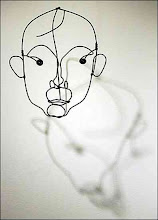It essentially goes like this—the brain holds many little specialists or bots or machines or functions or daemons or departments or tools (or some other term you’d like that indicates a non-aware device that is designed to do a particular job) that go about doing their jobs quite well (whether that’s recognizing letter/sound combinations, recognizing color, processing depth, etc. etc.), and when they’ve done their jobs they all talk to each other along amazingly rich connective paths and figure out who has the best information or best combination of information for the particular moment. That is, processing (and “consciousness”) is distributed across the brain rather than being localized in a particular center or arbiter; it is an alternative to the Cartesian model, which posits a kind of “theatre” model in which “we” are the consumers of our own consciousness (as opposed to being our own consciousness). In the Cartesian model, the processing happens and then it gets delivered to the “conscious” area of the brain; in the workspace model, there is no difference between the processing and the coming into consciousness. I’m oversimplifying here, but I don’t think I’m misrepresenting; if I am, I welcome correction (I’m no specialist!)
In this model, association clearly jumps into the front and center among modes of thinking. In his great tome Consciousness Explained, Dennett offers an excellent description of how our episodic memory might work: great associative chains of links with multiple redundancies so that any one memory is connected (hyperlinked) to many other memories (so maybe, more accurately, multihyperlinked).
.. in place of the precise, systematic “fetch-execute cycle” or “instruction cycle” that brings each new instruction to the instruction register to be executed, we should look for imperfectly marshaled, somewhat wandering, far-from-logical transition “rules,” where the brain’s largely innate penchant for “free association” is provided with longish association-chains to more or less ensure that the right sequences get tried out. (225)
I need not draw out here the obvious implications for imagination, association, brainstorming, etc.. What this all implies, to me at least, is that the associative thinking that we find commonly in poetry may be the most “natural”, or at least the most direct, form of thinking. Hofstadter carries the train of (associative) thought one step further and says that analogy building is at the core of consciousness (that's another long post). Robert Bly, of course, makes association (or “leaping”) the center of his argument in Leaping Poetry, but we need not assume that the leaping be done from image to image. The kind of linguistic association or wordplay you find in Charles Bernstein, Ron Silliman, John Ashbery, et al. is certainly a kind of leaping, and Bly says so. What’s interesting, though, is that we need not limit ourselves to imagistic leaping or to linguistic leaping. Bly, though, in his arguments for transparency of language (despite the opacity of image in some of the poets he endorses) seems to want to say that the language (the words) themselves don’t matter. And one might deduce just that from his translation practice—it’s what’s behind the words that matter to him.
So I suppose what I’m wondering here is whether there might be a parallelism between thought in the brain and language in the world—and whether there is no "behind". The human brain’s processing of information is consciousness; the language used to leap is the leap itself (rather than merely representing some quasi-mystical content in the images themselves).
I think Marinetti recognized or at least sensed this relationship. While he said that imagery is the lifeblood of poetry, he also called for speed, immediacy (non-mediation), precision (or prescision), minimal punctuation, disruption of syntax, and using only nouns and verbs. His attempt to get at the immediate image was through efficiency of language. There is no behind the language; the images are the language. Marinetti was trying to get the most direct access possible to the brain.
Marinetti, like Breton, was also interested in dramatic analogies, images, metaphors—assembling disparate objects into the same cognitive space. For Breton, these “collisions” brought together the dream world and the waking world; Bly wants images to bring together the shadow world and the world of light. They all seem interested in a poetry made of the most basic brain stuff.
But Marinetti used some interesting language in his “Technical Manifesto of Futurist Literature” that seems relevant to the multiple drafts model: “Analogy is nothing more than the deep love that assembles distant, seemingly diverse and hostile things. An orchestral style, at once polychromatic, polyphonic, and polymorphous, can embrace the life of matter only by means of the most extensive analogies.”
I suspect neither Dennett nor Hofstadter could come up with a more vivid analogy for the many drafts model; Hofstadter would love it, because it’s an analogy for analogy.




Vide Pound's translation of Fenollosa. He makes the same points better than Marinetti, I think. Pound was wrong about Chinese, but right abt perception. (And he was a better poet than Marinetti.) I wonder why all these early studiers of consciousness were fascisti? Ultimately, I think the greatest (unsystematic) poet of consciousness qua consciousness was Rimbaud.
ReplyDelete